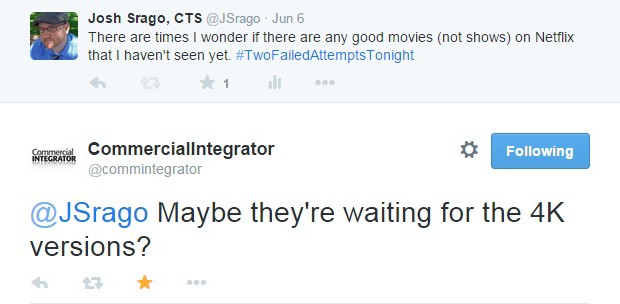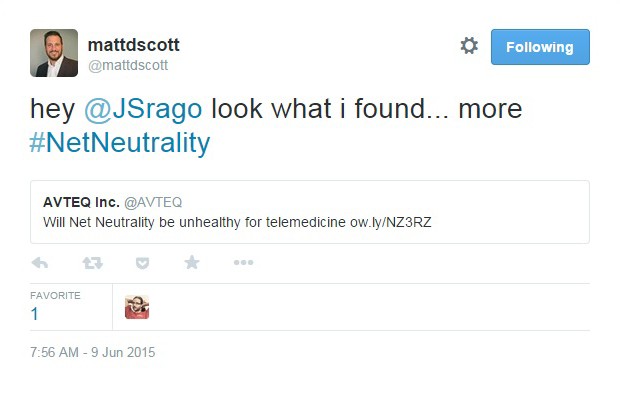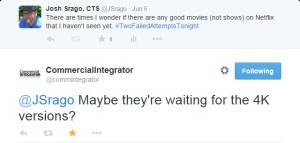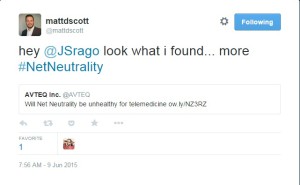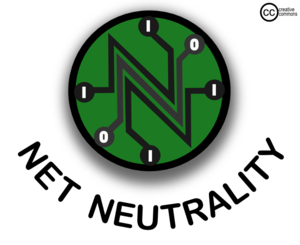My morning drive to work is a relatively long one at 49 miles from home to office. In that time I often have conversations with those in earlier time zones that have been up for a while, or get pinged on various forms of social media about subjects that I will respond to when I get somewhere safe. This week, though, has seemed to bring a daily request for me to continue to the conversation about Net Neutrality in the AV industry.
Commercial Integrator magazine’s twitter handle teased me with Netflix potentially waiting on good movie material until they could broadcast it in 4K.
Matt Scott shared an article with me about how the current Open Internet rules could affect the future development of healthcare technology.
And Tim Albright threw a jab after I shared a link about SpaceX looking to launch satellite based Internet by 2020.
It seems I’m being asked for a Net Neutrality update, so here you are folks!
Tomorrow, June 12th, is the official date that the new FCC rules will take effect and we get to see the new world order of what they bring. It could be a lot of changes, it could be absolutely nothing. It’s too hard to gauge at this point what’s going to happen because there are still so many pending lawsuits filed against the FCC regarding their ability to reclassify broadband under Title II that we don’t know where the chips will fall when all is said and done.
The courts could state that what the FCC has done was beyond its ability. The courts could throw out every lawsuit and just leave the rules as they currently stand.
I have learned a few things, though, since covering FCC Chairman Wheeler’s presentation at the NAB show. First and foremost, after discussing the issues with a representative from a leading telecommunications law firm, Fletcher, Heald & Hildreth, I learned that my conclusions on the possible affects these rules could have on the AV industry are all true.
The discussion yielded some interesting talking points regarding which aspects of the rules I was focusing my attention on and the weight those parts may carry. (ie: Does the undefined “application” level descriptor discussed as part of the exclusions really matter as much as I think it does?) But the overall consensus was that the ISPs will have the ability to block, throttle, or force paid prioritization for the data that the AV industry is passing over WANs and Internet connections.
The part of the conversation that tied me up was when I was asked the question, “what has the AV industry done to make this issue known?” It’s well documented how many times I’ve written about, discussed, hosted panels, or just screamed from the mountain tops about the topic, but it’s also been brought to my attention several times from several people that it seems I’m the only one talking about it (on every single platform I can find). I didn’t have an answer as to what the industry bodies have done to promote action by members on the issue because I truly haven’t seen a big push about the need to take action.
The follow up to that was the answer to the question that I get most frequently, “what can we do?” It turns out the answer is wait and watch. Due to the fact that this these rules are going to cause a shift in how data is treated on the networks, the AV industry as a whole is going to need to be a watchdog to determine if our data is being treated differently going forward. If we find that certain ISPs are blocking or throttling our data, and can demonstrate that this is taking place regularly and interfering with our business, we then have a case that can be presented to the FCC for consideration to alter the rules so that we are protected by the Title II reclassification.
It’s that simple folks! Now is the time to watch diligently and monitor how the ISPs are treating our data over VPNs, or our video conferencing signals, or any data that we distribute over a WAN. It’s up to the industry members as a whole to monitor this and report it so that we can keep ourselves safe and protected moving forward.

